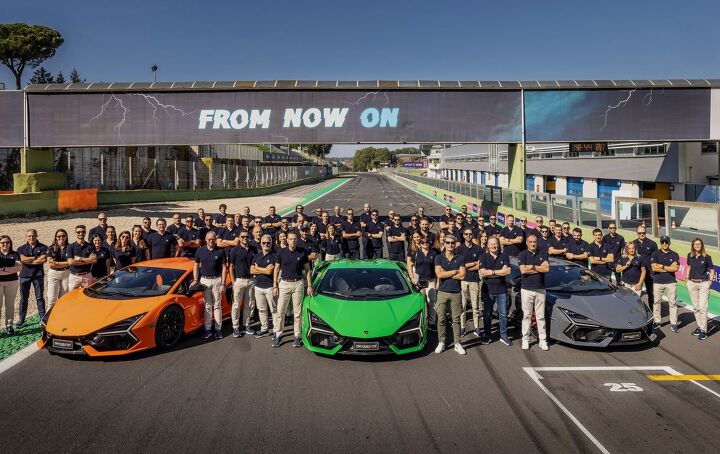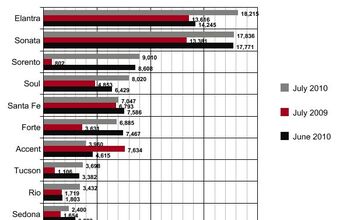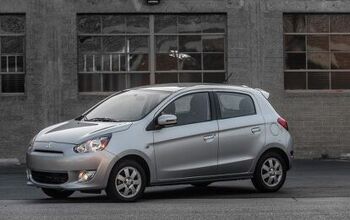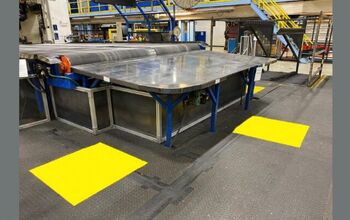Lamborghini Breaks Historic Sales Record

Lamborghini has broken its own sales record by delivering over 10,000 automobiles in 2023. While that’s still less than mainstream manufacturers are pushing out the door in a given week, it represents a major shift in how the brand does business and will likely open it up to additional regulatory scrutiny.
Sales were primarily driven by the Urus, with 6,087 vehicles delivered, and the Huracán, boasting 3,962 units. Analysts have suggested that something like this may not have been possible a decade ago. But with global wealth being transferred upward in recent years, Lamborghini was afforded an opportunity to draw in additional customers with its entry level products. Though, despite these being Lamborghini’s most affordable models, both the Huracán and Urus retail well above $200,000.
From Lamborghini:
The distribution of vehicles delivered was balanced in the three macro-regions, with EMEA showing a 14 [percent] increase over 2022 with a total of 3,987 cars, immediately followed by Americas with a 9 [percent] increase (Total: 3,465) and APAC up 4 [percent] (Total: 2,660). In detail, the United States continued as the top market with 3,000 cars delivered, followed by Germany (961), Chinese Mainland, Hong Kong and Macau (845), the United Kingdom (801), Japan (660), the Middle East (496), South Korea (434), Italy (409), Canada (357), Australia (263), France & Monaco (255), Switzerland (211), Taiwan (131) and India (103).
In terms of model split, the continuing success of the Urus Super SUV was confirmed (6,087 vehicles delivered), followed by another notable record for the Huracán, of which 3,962 cars were delivered. In addition, 63 cars equipped with the iconic V12 were delivered, including the last 12 Aventadors and 51 Few-Offs.
“It’s a true source of pride for the whole company to have surpassed the 10,000-car delivery mark. Playing a role in achieving this milestone for Lamborghini is an honor for me and for all the people who work tirelessly to achieve this goal,” stated Stephan Winkelmann, Chairman and CEO of Automobili Lamborghini. “This is a success made possible by the commitment of everyone, a major accomplishment based on true teamwork. But as always, we’re not stopping at single milestones, and we’re ready to take on more exciting new challenges in 2024.”
While the sales are good news for the brand, breaking the 10,000-unit barrier could come with some complications. The European Union had previously considered allowing specialty, low-volume manufacturers leeway when it comes to adhering to ever-tightening emissions rules. But it has started to move away from the scheme and is still planning to force all manufacturers to stop building everything but all-electric vehicles by 2035. While companies building fewer than 10,000 vehicles annually weren’t subject to the same emissions standards as the big boys, they’re still supposed to prepare for electrification if they want to continue doing business in Europe.
A subset of boutique manufacturers have attempted to convince the EU to rethink the plan by offering exemptions to low-volume brands on the grounds that their products aren’t transportation products but mobile works of rolling art. The premise is that they’re different from mainstream automobiles and should be treated as such.
“We create art pieces that exist for 100 years or more, so they’re not mass-production cars you throw away after 15 years,” Donkervoort Automobielen Managing Director Denis Donkervoort said early in 2023. “We know this because more than 99 [percent] of the cars we’ve ever built are still drivable, and we know this because we still service them.”
Donkervoort and a handful of other low-volume manufacturers are hoping to get around European regulations that would force them to halve CO2 emissions by 2030 and go fully electric by 2035. But they’re targeting an indefinite exemption for automakers building fewer than 1,000 vehicles per year, which wouldn’t pertain to Lamborghini even if it stopped selling the Urus tomorrow.
The theory here could be applied to companies like Lamborghini, however. Boutique brands have alleged that they produce vehicles in such small quantities that the overall carbon footprint is minuscule. Though the kind of people that buy those products are likely to have a much larger impact on the environment than your neighbor who drives an Honda CR-V and won’t need to heat a 10,000 square-foot mansion or fuel the private jet they also don’t own.
Regardless, Lamborghini now sells enough cars to put itself into a different category unless industry regulators are swayed by corporate lobbying efforts. But the Italian brand has fielded several all-electric concepts in recent years and has claimed 2024 will represent its first big push into transitioning its fleet to EVs, now that the time it allotted itself as a “celebration of the internal combustion engine” has concluded.
[Image: Lamborghini]
Become a TTAC insider. Get the latest news, features, TTAC takes, and everything else that gets to the truth about cars first by subscribing to our newsletter.

A staunch consumer advocate tracking industry trends and regulation. Before joining TTAC, Matt spent a decade working for marketing and research firms based in NYC. Clients included several of the world’s largest automakers, global tire brands, and aftermarket part suppliers. Dissatisfied with the corporate world and resentful of having to wear suits everyday, he pivoted to writing about cars. Since then, that man has become an ardent supporter of the right-to-repair movement, been interviewed on the auto industry by national radio broadcasts, driven more rental cars than anyone ever should, participated in amateur rallying events, and received the requisite minimum training as sanctioned by the SCCA. Handy with a wrench, Matt grew up surrounded by Detroit auto workers and managed to get a pizza delivery job before he was legally eligible. He later found himself driving box trucks through Manhattan, guaranteeing future sympathy for actual truckers. He continues to conduct research pertaining to the automotive sector as an independent contractor and has since moved back to his native Michigan, closer to where the cars are born. A contrarian, Matt claims to prefer understeer — stating that front and all-wheel drive vehicles cater best to his driving style.
More by Matt Posky
Latest Car Reviews
Read moreLatest Product Reviews
Read moreRecent Comments
- FreedMike Not surprisingly, I have some ideas. What Cadillac needs, I think, is a statement. They don’t really have an identity. They’re trying a statement car with the Celestiq, and while that’s the right idea, it has the wrong styling and a really wrong price tag. So, here’s a first step: instead of a sedan, do a huge, fast, capable and ridiculously smooth and quiet electric touring coupe. If you want an example of what I’m thinking of, check out the magnificent Rolls-Royce Spectre. But this Cadillac coupe would be uniquely American, it’d be named “Eldorado,” and it’d be a lot cheaper than the $450,000 Spectre – call it a buck twenty-five, with a range of bespoke options for prospective buyers that would make each one somewhat unique. Make it 220 inches long, on the same platform as the Celestiq, give it retro ‘60s styling (or you could do a ‘50s or ‘70s throwback, I suppose), and at least 700 horsepower, standard. Why electric? It’s the ultimate throwback to ‘60s powertrains: effortlessly fast, smooth, and quiet, but with a ton more horsepower. It’s the perfect drivetrain for a dignified touring coupe. In fact, I’d skip any mention of environmental responsibility in this car’s marketing – sell it on how it drives, period. How many would they sell? Not many. But the point of the exercise is to do something that will turn heads and show people what this brand can do. Second step: give the lineup a mix of electric and gas models, and make Cadillac gas engines bespoke to the brand. If they need to use generic GM engine designs, fine – take those engines and massage them thoroughly into something special to Cadillac, with specific tuning and output. No Cadillac should leave the factory with an engine straight out of a Malibu or a four-banger Silverado. Third step: a complete line-wide interior redo. Stop the cheapness that’s all over the current sedans and crossovers. Just stop it. Use the Lyriq as a blueprint – it’s a big improvement over the current crop and a good first step. I’d also say Cadillac has a good blend of screen-controlled and switch-controlled user interfaces; don’t give into the haptic-touch and wall-to-wall screen thing. (On the subject of Caddy interiors – as much as I bag on the Celestiq, check out the interior on that thing. Wow.)Fourth step: Blackwing All The Things – some gas, others electric. And keep the electric/gas mix so buyers have a choice.Fifth step: be patient. That’s not easy, but if they’re doing a brand reset, it’ll take time.
- NJRide So if GM was serious about selling this why no updates for so long? Or make something truly unique instead of something that looked like a downmarket Altima?
- Kmars2009 I rented one last fall while visiting Ohio. Not a bad car...but not a great car either. I think it needs a new version. But CUVs are King... unfortunately!
- Ajla Remember when Cadillac introduced an entirely new V8 and proceeded to install it in only 800 cars before cancelling everything?
- Bouzouki Cadillac (aka GM!!) made so many mistakes over the past 40 years, right up to today, one could make a MBA course of it. Others have alluded to them, there is not enough room for me to recite them in a flowing, cohesive manner.Cadillac today is literally a tarted-up Chevrolet. They are nice cars, and the "aura" of the Cadillac name still works on several (mostly female) consumers who are not car enthusiasts.The CT4 and CT5 offer superlative ride and handling, and even performance--but, it is wrapped in sheet metal that (at least I think) looks awful, with (still) sub-par interiors. They are niche cars. They are the last gasp of the Alpha platform--which I have been told by people close to it, was meant to be a Pontiac "BMW 3-series". The bankruptcy killed Pontiac, but the Alpha had been mostly engineered, so it was "Cadillac-ized" with the new "edgy" CTS styling.Most Cadillacs sold are crossovers. The most profitable "Cadillac" is the Escalade (note that GM never jack up the name on THAT!).The question posed here is rather irrelevant. NO ONE has "a blank check", because GM (any company or corporation) does not have bottomless resources.Better styling, and superlative "performance" (by that, I mean being among the best in noise, harshness, handling, performance, reliablity, quality) would cost a lot of money.Post-bankruptcy GM actually tried. No one here mentioned GM's effort to do just that: the "Omega" platform, aka CT6.The (horribly misnamed) CT6 was actually a credible Mercedes/Lexus competitor. I'm sure it cost GM a fortune to develop (the platform was unique, not shared with any other car. The top-of-the-line ORIGINAL Blackwing V8 was also unique, expensive, and ultimately...very few were sold. All of this is a LOT of money).I used to know the sales numbers, and my sense was the CT6 sold about HALF the units GM projected. More importantly, it sold about half to two thirds the volume of the S-Class (which cost a lot more in 201x)Many of your fixed cost are predicated on volume. One way to improve your business case (if the right people want to get the Green Light) is to inflate your projected volumes. This lowers the unit cost for seats, mufflers, control arms, etc, and makes the vehicle more profitable--on paper.Suppliers tool up to make the number of parts the carmaker projects. However, if the volume is less than expected, the automaker has to make up the difference.So, unfortunately, not only was the CT6 an expensive car to build, but Cadillac's weak "brand equity" limited how much GM could charge (and these were still pricey cars in 2016-18, a "base" car was ).Other than the name, the "Omega" could have marked the starting point for Cadillac to once again be the standard of the world. Other than the awful name (Fleetwood, Elegante, Paramount, even ParAMOUR would be better), and offering the basest car with a FOUR cylinder turbo on the base car (incredibly moronic!), it was very good car and a CREDIBLE Mercedes S-Class/Lexus LS400 alternative. While I cannot know if the novel aluminum body was worth the cost (very expensive and complex to build), the bragging rights were legit--a LARGE car that was lighter, but had good body rigidity. No surprise, the interior was not the best, but the gap with the big boys was as close as GM has done in the luxury sphere.Mary Barra decided that profits today and tomorrow were more important than gambling on profits in 2025 and later. Having sunk a TON of money, and even done a mid-cycle enhancement, complete with the new Blackwing engine (which copied BMW with the twin turbos nestled in the "V"!), in fall 2018 GM announced it was discontinuing the car, and closing the assembly plant it was built in. (And so you know, building different platforms on the same line is very challenging and considerably less efficient in terms of capital and labor costs than the same platform, or better yet, the same model).So now, GM is anticipating that, as the car market "goes electric" (if you can call it that--more like the Federal Government and EU and even China PUSHING electric cars), they can make electric Cadillacs that are "prestige". The Cadillac Celestique is the opening salvo--$340,000. We will see how it works out.


































Comments
Join the conversation
You couldn't GIVE me one of those over-hyped over-priced Lambo-Goonies.
Tesla Model Y first EV to be Europe's No. 1 seller | Automotive News Europe (autonews.com)
Speaking of EPIC sales records by an automaker who was just an upstart joke, barely on the radar screen, 12 years ago.
Oh, and you can bet I am the REAL Tassos, not the coward identity thief punk vegetating around here.